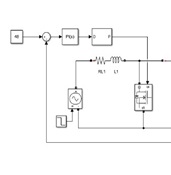Convertidor SEPIC: modelado y control considerando pérdidas de energía interna
Contenido principal del artículo
En este artículo se describe el procedimiento que permite diseñar un controlador para un convertidor Sepic de 2 kilovatios con elementos no ideales que puede ser usado en aplicaciones industriales. Se obtiene el modelo conmutado del convertidor a partir de los modos de operación, con este se construye el modelo en pequeña señal que permite obtener la función de transferencia necesaria para el diseño del controlador análogo, garantizado un tiempo de establecimiento de 25 ms. Se muestran los resultados de simulación usando MATLAB®/SIMULINK® alrededor del punto de operación realizando perturbaciones a la salida del convertidor y variaciones en el voltaje DC de entrada, evaluando el desempeño del sistema en el dominio temporal. Con el controlador diseñado se satisface la especificación de diseño para las resistencias internas de los inductores hasta 0.3 Ohmnios.
Mumtaz F, Zaihar Yahaya N, Tanzim Meraj S, Singh B, Kannan R, Ibrahim O. Review on non-isolated DC-DC converters and their control techniques for renewable energy applications. Ain Shams Eng J [Internet]. 2021;12(4):3747–63. Available from: https://www.sciencedirect.com/science/article/pii/S2090447921001933 DOI: https://doi.org/10.1016/j.asej.2021.03.022
Sivakumar S, Sathik MJ, Manoj PS, Sundararajan G. An assessment on performance of DC–DC converters for renewable energy applications. Renew Sustain Energy Rev [Internet]. 2016;58:1475–85. Available from: https://www.sciencedirect.com/science/article/pii/S1364032115014409 DOI: https://doi.org/10.1016/j.rser.2015.12.057
Mouslim S, Oubella M, Kourchi M, Ajaamoum M. Simulation and analyses of SEPIC converter using linear PID and fuzzy logic controller. Mater Today Proc [Internet]. 2020;27:3199–208. Available from: https://www.sciencedirect.com/science/article/pii/S221478532033128X DOI: https://doi.org/10.1016/j.matpr.2020.04.506
Ayachit A, Reatti A, Kazimierczuk MK. Small-signal modeling of PWM dual-SEPIC dc-dc converter by circuit averaging technique. In: IECON 2016 - 42nd Annual Conference of the IEEE Industrial Electronics Society. 2016. p. 3606–11. DOI: https://doi.org/10.1109/IECON.2016.7793030
Polsky T, Horen Y, Bronshtein S, Baimel D. Transient and Steady-State Analysis of a SEPIC Converter by an Average State-Space Modelling. In: 2018 IEEE 18th International Power Electronics and Motion Control Conference (PEMC). 2018. p. 211–5. DOI: https://doi.org/10.1109/EPEPEMC.2018.8522000
Kanimozhi G, Meenakshi J, Sreedevi VT. Small Signal Modeling of a DC-DC Type Double Boost Converter Integrated With SEPIC Converter Using State Space Averaging Approach. Energy Procedia [Internet]. 2017;117:835–46. Available from: https://www.sciencedirect.com/science/article/pii/S1876610217324426 DOI: https://doi.org/10.1016/j.egypro.2017.05.201
Poluthai S, Jirasuwankul N. Simulation of a Miniature SEPIC Converter with PI Controller for Thermoelectric Generator Module. In: 2018 International Electrical Engineering Congress (iEECON). 2018. p. 1–4. DOI: https://doi.org/10.1109/IEECON.2018.8712248
Hussain J, Mishra MK. Design of current mode controlled SEPIC DC-DC converter for MPPT control of wind energy conversion systems. In: 2015 International Conference on Computation of Power, Energy, Information and Communication (ICCPEIC). 2015. p. 177–82. DOI: https://doi.org/10.1109/ICCPEIC.2015.7259460
Geethalakshmi B. Design of a closed loop control scheme for a DC-DC SEPIC converter using loop shaping method. In: 2015 International Conference on Circuits, Power and Computing Technologies [ICCPCT-2015]. 2015. p. 1–5. DOI: https://doi.org/10.1109/ICCPCT.2015.7159361
Sivamani D, Ramkumar R, Nazar Ali A, Shyam D. Design and implementation of highly efficient UPS charging system with single stage power factor correction using SEPIC converter. Mater Today Proc [Internet]. 2021;45:1809–19. Available from: https://www.sciencedirect.com/science/article/pii/S221478532036627X DOI: https://doi.org/10.1016/j.matpr.2020.08.744
Sel A, Güneş U, Elbir Ö, Kasnakoğlu C. Comparative analysis of performance of the SEPIC converter using LQR and PID controllers. In: 2017 21st International Conference on System Theory, Control and Computing (ICSTCC). 2017. p. 839–44. DOI: https://doi.org/10.1109/ICSTCC.2017.8107141
Chandan B, Dwivedi P, Bose S. Closed Loop Control of SEPIC DC-DC Converter Using Loop Shaping Control Technique. In: 2019 IEEE 10th Control and System Graduate Research Colloquium (ICSGRC). 2019. p. 20–5. DOI: https://doi.org/10.1109/ICSGRC.2019.8837093
Gayen PK, Roy Chowdhury P, Dhara PK. An improved dynamic performance of bidirectional SEPIC-Zeta converter based battery energy storage system using adaptive sliding mode control technique. Electr Power Syst Res [Internet]. 2018;160:348–61. Available from: https://www.sciencedirect.com/science/article/pii/S0378779618300889 DOI: https://doi.org/10.1016/j.epsr.2018.03.016
Elsayad N, Moradisizkoohi H, Mohammed O. A New SEPIC-Based Step-Up DC-DC Converter With Wide Conversion Ratio for Fuel Cell Vehicles: Analysis and Design. IEEE Trans Ind Electron. 2021;68(8):6390–400. DOI: https://doi.org/10.1109/TIE.2020.3007110
Arany RR, Bratcu AI. Robust control of a single-ended primary-inductor converter (SEPIC). In: 2017 5th International Symposium on Electrical and Electronics Engineering (ISEEE). 2017. p. 1–6. DOI: https://doi.org/10.1109/ISEEE.2017.8170665
Ullah M, Ulasyar A, Zad HS, Khattak A. Design of Linear Quadratic Regulator Controller for Sepic Converter. In: 2019 15th International Conference on Emerging Technologies (ICET). 2019. p. 1–6. DOI: https://doi.org/10.1109/ICET48972.2019.8994463
Bacha S, Munteanu I, Bratcu AI. “Power Electronic Converters Modeling and Control”, Advanced Textbooks in Control and Signal Processing [Internet]. London: Springer; 2014. Available from: http://dx.doi.org/10.1007/978-1-4471-5478-5 DOI: https://doi.org/10.1007/978-1-4471-5478-5
Kircioğlu O, Ünlü M, Çamur S. Modeling and analysis of DC-DC SEPIC converter with coupled inductors. In: 2016 International Symposium on Industrial Electronics (INDEL). 2016. p. 1–5. DOI: https://doi.org/10.1109/INDEL.2016.7797807
Verma M, Kumar SS. Hardware Design of SEPIC Converter and its Analysis. In: 2018 International Conference on Current Trends towards Converging Technologies (ICCTCT). 2018. p. 1–4. DOI: https://doi.org/10.1109/ICCTCT.2018.8551052
Nishat MM, Oninda MAM, Faisal F, Hoque MA. Modeling, Simulation and Performance Analysis of SEPIC Converter Using Hysteresis Current Control and PI Control Method. 2018 Int Conf Innov Sci Eng Technol ICISET 2018. 2018;(October):7–12. DOI: https://doi.org/10.1109/ICISET.2018.8745619
Goudarzian A, Khosravi A, Raeisi HA. A new approach in design of sliding-mode voltage-controller for a SEPIC. Int J Dyn Control [Internet]. 2021;9(3):1197–209. Available from: https://doi.org/10.1007/s40435-020-00741-9 DOI: https://doi.org/10.1007/s40435-020-00741-9
Sree BL, Umamaheswari MG. Modeling and control of solar power fed single ended primary inductor converter using cascade control scheme. In: 2017 Trends in Industrial Measurement and Automation (TIMA). 2017. p. 1–7. DOI: https://doi.org/10.1109/TIMA.2017.8064784
Aceptado 2024-02-12
Publicado 2024-02-26

Esta obra está bajo una licencia internacional Creative Commons Atribución-NoComercial-CompartirIgual 4.0.
Los autores que publican en esta revista están de acuerdo con los siguientes términos:
Los autores ceden los derechos patrimoniales a la revista y a la Universidad del Valle sobre los manuscritos aceptados, pero podrán hacer los reusos que consideren pertinentes por motivos profesionales, educativos, académicos o científicos, de acuerdo con los términos de la licencia que otorga la revista a todos sus artículos.
Los artículos serán publicados bajo la licencia Creative Commons 4.0 BY-NC-SA (de atribución, no comercial, sin obras derivadas).





